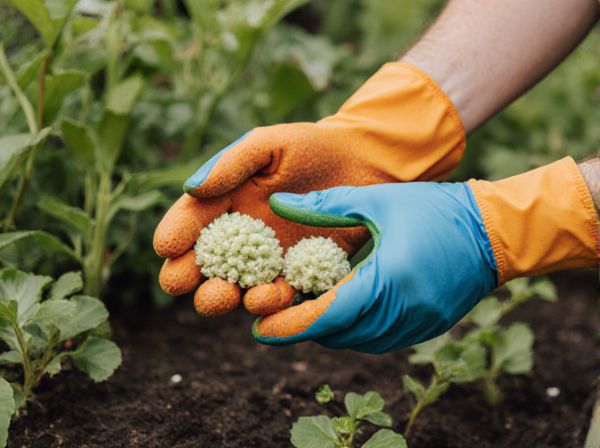
Bacillus thuringiensis vs Spinosad Illustration
Bacillus thuringiensis (Bt) and Spinosad are both effective biopesticides used to control insect pests, yet they differ in their mode of action and target spectrum. Bt produces toxins that specifically target the gut of caterpillars and certain beetle larvae, causing paralysis and death upon ingestion. Spinosad, derived from bacterial fermentation, affects the nervous system of a broader range of pests including thrips and leafminers, offering rapid knockdown and residual control.
Table of Comparison
| Aspect | Bacillus thuringiensis (Bt) | Spinosad |
|---|---|---|
| Type | Biological insecticide (bacteria-based) | Biochemical insecticide (fermentation-derived) |
| Mode of Action | Produces toxins that disrupt insect gut cells | Targets insect nervous system causing paralysis |
| Target Pests | Larvae of Lepidoptera (moths, butterflies), some Diptera, Coleoptera | Leafminers, thrips, caterpillars, beetles, fruit flies |
| Application | Foliage spray, soil treatment | Foliar spray |
| Residual Effect | Short-lived; degrades quickly in sunlight | Moderate; lasts several days to weeks |
| Environmental Impact | Low toxicity to non-target organisms and beneficial insects | Low to moderate; toxic to some beneficial insects if exposed |
| Resistance Management | Some resistance reported; rotation advised | Resistance possible; integrate with other controls |
| Usage | Organic and conventional farming | Primarily conventional; approved for some organic use |
Bacillus thuringiensis vs Spinosad: An Overview
Bacillus thuringiensis (Bt) is a naturally occurring soil bacterium producing insecticidal toxins effective against caterpillars, whereas Spinosad is a fermentation-derived compound targeting a broader range of pests including thrips and leaf miners. Bt primarily disrupts the gut lining of Lepidopteran larvae, offering specificity and safety for beneficial insects, while Spinosad acts on the nervous system, providing rapid knockdown but with moderate non-target effects. Both biopesticides serve critical roles in integrated pest management by minimizing chemical pesticide usage and reducing environmental impact.
How Bacillus thuringiensis Works Against Garden Pests
Bacillus thuringiensis (Bt) targets garden pests by producing toxic proteins that attack the gut lining of specific insects, causing them to stop feeding and eventually die. This bacterium is highly effective against caterpillars, beetle larvae, and other soft-bodied insects, making it a preferred organic pesticide. Unlike Spinosad, which affects the nervous system of insects, Bt offers selective control with minimal impact on beneficial insects and pollinators.
The Mechanism of Action of Spinosad
Spinosad targets the insect nervous system by binding to nicotinic acetylcholine receptors, causing continuous nerve stimulation that leads to paralysis and death. Unlike Bacillus thuringiensis, which produces specific toxins that disrupt the insect gut lining, Spinosad acts as a neurotoxin with rapid ingestion and contact effects. This mode of action makes Spinosad highly effective against a broad spectrum of pests, including resistant insect populations.
Target Pest Spectrum: Bt vs. Spinosad
Bacillus thuringiensis primarily targets lepidopteran larvae, including caterpillars and certain mosquito species, by producing specific Cry proteins toxic to these pests. Spinosad exhibits a broader target pest spectrum, affecting lepidopteran, dipteran, and coleopteran insects through neurotoxic effects on nicotinic acetylcholine and GABA receptors. Both biopesticides provide effective control but vary in specificity, with Bt being highly selective and Spinosad offering versatility against multiple pest orders.
Safety for Beneficial Insects and Pollinators
Bacillus thuringiensis (Bt) is highly specific to target pests, posing minimal risk to beneficial insects and pollinators, making it a safe choice for integrated pest management. Spinosad, although effective against a wide range of pests, can have moderate toxicity to some pollinators, especially if applied during flowering periods. Utilizing Bt ensures protection of ecological balance by preserving pollinator populations vital for crop pollination and biodiversity.
Application Methods and Best Practices
Bacillus thuringiensis (Bt) is primarily applied as a foliar spray targeting specific larvae through ingestion, requiring thorough coverage of plant surfaces for optimal effectiveness. Spinosad can be used both as a foliar spray and soil drench, offering broader pest control by disrupting the nervous system of insects upon contact or ingestion. Best practices include applying Bt in the early larval stages and under cooler temperatures to preserve bacterial spores, while Spinosad should be used in low-light conditions to prevent rapid degradation.
Environmental Impact: Comparing Bt and Spinosad
Bacillus thuringiensis (Bt) is a naturally occurring soil bacterium that produces toxins targeting specific insect larvae, minimizing harm to beneficial insects and pollinators. Spinosad, derived from soil bacteria Saccharopolyspora spinosa, affects a broader range of insects but poses moderate toxicity risks to non-target aquatic organisms and bees. Both pest control agents degrade rapidly in the environment, but Bt is generally considered more environmentally friendly due to its specificity and lower non-target impact.
Resistance Management Strategies
Bacillus thuringiensis (Bt) and Spinosad are pivotal in resistance management strategies due to their distinct modes of action against pest populations. Bt produces specific toxins targeting insect larvae, reducing the likelihood of cross-resistance when integrated with Spinosad, which disrupts pest nervous systems through unique metabolite interactions. Utilizing these agents in rotation or combination enhances sustainable pest control by delaying resistance development and preserving efficacy in integrated pest management (IPM) programs.
Cost and Accessibility for Home Gardeners
Bacillus thuringiensis (Bt) is generally more affordable and widely available in garden centers and online, making it a cost-effective option for home gardeners seeking organic pest control. Spinosad tends to be priced higher but offers broader pest control efficacy and longer residual activity, which may justify the expense for targeted applications. Both products are relatively accessible, but Bt's lower cost and simpler usage make it the preferred choice for budget-conscious home gardeners.
Choosing the Best Organic Pest Control for Your Garden
Bacillus thuringiensis (Bt) targets specific caterpillar larvae by producing proteins that disrupt their digestive systems, making it highly effective against Lepidoptera pests. Spinosad, derived from Saccharopolyspora spinosa bacteria, offers broader insect control including thrips, leafminers, and certain beetles with rapid knockdown effects. For organic garden pest control, Bt excels in precision targeting of caterpillars without harming beneficial insects, while Spinosad provides versatile coverage but requires careful application to minimize impact on pollinators.
Bacillus thuringiensis vs Spinosad Infographic

 gardendif.com
gardendif.com